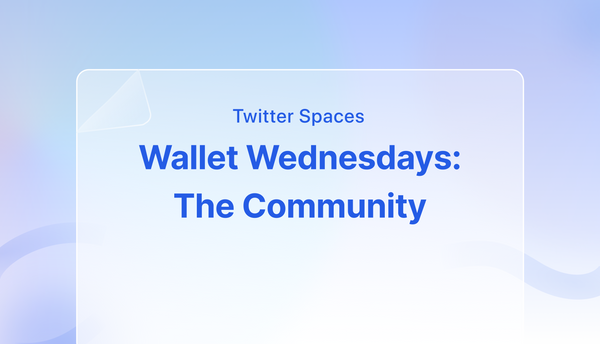Wallet Wednesdays is a series of Twitter Spaces conversations where we bring together builders, designers, leaders, and thinkers who are pioneering the non-custodial wallet user experience.
In the previous session, we discussed crypto wallet design and heard from product and design leaders.
This time, Wallet Wednesdays focused on community.
Often the community is what drives the development of products in crypto. And it’s even more critical for wallets, through which people directly experience Web3.
The speakers that week included:
- Rebecca Mqamelo, Head of Growth at Zerion
- Abishek Dharshan, Head of Community at Zerion
- Chintan Turakhia, Director Of Engineering at Coinbase Wallet
- Tanya Efremova, Product Designer at Gnosis Safe
- NaxSun, Tally Ho
- Chris Jones, Community at Tally Ho
Top Web3 communities
To foster your own successful community it's important to learn from others.
To kick start the discussion, speakers shared some of the most exciting Web3 communities where they are members:
- Kernel — a Web3 fellowship that focuses on education,
- WGMI.Community — a community for community builders and product managers,
- Threshold Network — the community that was formed from Keep and NuCypher, the first on-chain merge,
- Token Engineering Commons — a community dedicated to creating and designing tokens.
Designing a wallet in a community
Building a wallet together with a community is a new approach and Tally Ho is one of the projects that put the community aspect right in the center.
NaxSun shared how by listening to the community the team is figuring out what to focus on.
One example is wallet integrations. Tally has a working group dedicated to reaching out to projects. A few community developers there submit requests and the intent is to build partnerships. The community is also involved in testing, and every other aspect, NaxSun explained.
“How are you going to maximize the use of all of that energy and all of those ideas from all the people who want to contribute? The main task is to channel that into a system and into product design,” — NaxSun
Kris Jones added that giving the reins to the community and letting them show you what they can do with it as well as making sure that they're empowered is really important. For Tally Ho, planning a DAO and preparing for it is part of the process of involving the community early on.
Another key question to consider was suggested by Abishek Dharshan: "How do you let the community achieve its first win?"
The journey of a community member evolves with the product, Abi noted. The early feedback is purely driven by members. At a later stage, community members can generate content, offer support in local markets, and play other different roles.
Also unlike in traditional products, for wallets, a lot of the growth might come from the word of mouth.
“You need to reach a point where you early community members become superusers and marketers of your product” — Abi
Meanwhile, offering support to developers and dapps is a major part of community work for Coinbase Wallet, Chintan Turakhia explained. Together with all the builders who integrate the Coinbase Wallet they aim to answer the question:
“How do we onboard the next billing users in a safe way?”
At the same time, Coinbase Wallet’s community was involved in hosting workshops and creating educational content in local languages in countries like the Philippines and Vietnam. Even in countries for which Coinbase Wallet does not have language support, some community members were eager to create helpful content.
Sourcing feedback and dealing with information overload
As all speakers agreed, the community is a great source of insights.
At Gnosis Safe, the team aims to have a clear idea for whom the product is built.
Talking to users is crucial because that can reveal interesting and not immediately obvious cases. For example, Gnosis Safe is not only used by DAOs, Tanya Efremova explained.
Some of the interesting communities and use cases that Tanya mentioned:
- Friends/colleagues using a joint wallet
- Collaborative management of NFTs
- Personal multisig, where the same person uses several wallets to sign each transaction
Chintan shared several avenues that Coinbase Wallet uses to source user feedback:
- Internal Slack — team members are often the best users
- Degen Council — friends & family from across Web3
- Crypto Twitter
Yet it’s also possible to get too much information. The community is hardly ever at a loss of ideas and suggestions.
To deal with 'analysis paralysis', NaxSun suggested focusing on feature requests. Look at how many times people request something.
Confusion is another indicator of things that should be a priority, NaxSun added. Listen to what people don’t understand, look at where they get stuck the most often and change that, he explained.
The teams must balance between building out their vision and taking feedback from the community. Abi noted:
“Have a vision and be able to pivot on the fly.”
Next Wednesday
Based on the feedback from the previous Wallet Wednesdays, we decided to continue hosting them.
The next session will be dedicated to NFTs — and the Zerion team will be at ETH Amsterdam, so Wallet Wednesdays might even happen IRL!

